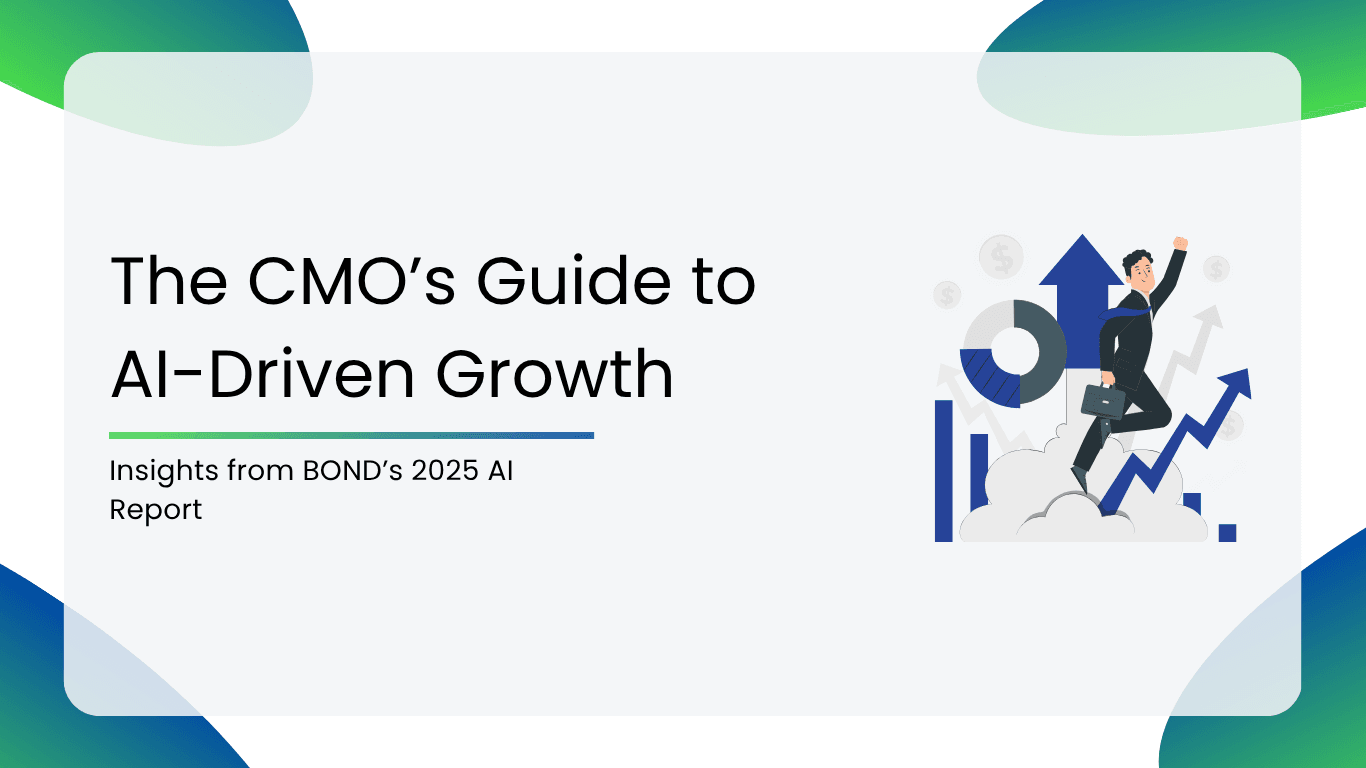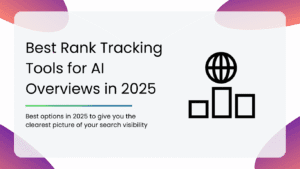BOND just dropped its 2025 Trends in Artificial Intelligence report—340 pages deep and packed with insight.
Let’s dive into the report through a marketing lens, where our focus is on driving growth, building brand relevance, and forging meaningful customer connections.
The massive report is nothing short of comprehensive. But here’s the bottom line for us as marketers: AI isn’t just another tech evolution; it’s a fundamental transformation of how we engage, convert, and grow. The change is fast, far-reaching, and already impacting every aspect of the customer journey.
So, what does this mean for CMOs, growth marketers, and brand leaders?
The Big Picture: What CMOs Need to Know
Here are the key insights that leapt off the page for us, and why they matter for marketing:
1. The Pace of Change Is Unmatched
- “Seem like change is happening faster than ever? Yes, it is.”
AI adoption is ramping up even faster than the early internet. For marketers, that’s a flashing red light: we can’t afford to take a ‘wait and see’ approach. The digital behaviours of our customers are shifting rapidly, and AI is at the core of that shift.
2. AI Is Rewriting the Customer Experience
Generative AI is set to reimagine everything from shopping and search to coding and communication. That means the touchpoints we carefully craft, ads, landing pages, emails, even chatbots, are up for reinvention. Our new goal? Experiences that are smarter, more intuitive, and dynamic.
3. AI Agents are Emerging as a New Interface
We’re entering the age of AI Agents, tools that act on behalf of users, executing tasks, making decisions, and navigating platforms. AI. These agents could potentially sit between the customer and traditional brand interfaces like websites or apps. As marketers, we must ask: How does our brand show up when a customer’s AI agent is doing the navigating?
4. Marketing Teams Are Already Leaning In
A striking stat: 75% of global CMOs are using or testing AI tools already. The adoption of AI in traditional enterprises is a ‘rising priority’. Specifically for global enterprises, the focus is shifting from purely cost reduction to driving growth & revenue.
5. Monetization and Competition are Intense and Evolving
With the rise of open-source models, subscription strategies, and even ads embedded in AI platforms like Google’s AI Overviews, attention is shifting, and so must our strategies. This intensely competitive and evolving landscape affects where audiences might be found and how attention is captured.
6. Data and Context Are the New Power Plays
The report highlights that the advantage goes to those who can “train on data fastest, personalize it deepest, and deploy it widest”. Brands that own the customer context, through data and AI-driven insights, will control the interface and win the attention of the consumers.
7. Specialised AI Tools Are Scaling Fast
The report shows explosive growth in AI-powered vertical SaaS, from legal and healthcare to finance and agriculture. For marketers, this means evaluating domain-specific tools that can give you a competitive edge in your niche.
Key Points or Actions a CMO Can Take
Here’s what we believe are the most critical actions to take:
1. Shift the Narrative from Efficiency to Growth
- Start framing AI not as a back-office automation tool, but as a revenue-growth engine, improving customer acquisition, marketing effectiveness, and post-sale engagement.
2. Aggressively Test and Integrate AI Tools
Go beyond just pilot testing and integrate AI into marketing functions. Testing isn’t enough. Begin integrating AI tools into core marketing processes:
- Creative generation (e.g., Adobe Firefly)
- Campaign analysis
- Personalisation at scale
- Content development with tools like ChatGPT Enterprise
3. Rethink Customer Journeys and Interfaces
- We need to design for an AI-first world, where customers may never touch our website. Instead, their AI agent might fetch product data, ask us questions, or complete transactions on their behalf. Are we ready to meet them in that interface?
Questions to consider: How will our brand interact when an AI agent is executing tasks for a user? How can we ensure our brand is present and helpful in these new AI-driven interfaces?
4. Deepen Personalisation and Contextual Marketing
AI enables “deeper” personalisation. The report links monetization to “attention, context, and control”. We need to leverage AI to understand customer context better and deliver hyper-personalised experiences and messaging across all touchpoints. This requires a robust data strategy.
- Investing in clean, structured, privacy-compliant data
- Building pipelines that fuel AI models
- Using AI to extract real-time contextual insights
5. Watch Emerging AI Platforms Closely
- Platforms like ChatGPT, Grok, Meta AI, and DeepSeek are becoming engagement ecosystems. If user attention is migrating there, and ad models are following, we need to experiment early.
6. Evaluate Specialised AI Software for Industry-Specific Advantage
- Explore specialised AI software relevant to our specific industries. These industry-specific AI tools may offer workflow depth, compliance, and ROI that generic tools can’t. This could offer a competitive edge.
7. Lead with Ethics and Privacy
- As AI personalisation deepens, ethical use of customer data becomes a brand differentiator. The report touches on privacy with Apple Intelligence and the need for truth-seeking AI (Grok). As we use more customer data for personalisation via AI, ensuring ethical practices, transparency, and robust data privacy becomes paramount for brand trust.
Implications for Growth Marketers and Brands Looking to Scale
- Lower Barrier to Entry for Advanced AI: The falling cost of inference and the increased availability of models, including open-source options, make powerful AI capabilities more accessible. This democratises advanced marketing techniques like hyper-personalisation, sophisticated analytics, and automated content generation that were previously only feasible for large corporations. Brands looking to scale can leverage these tools cost-effectively.
- New Avenues for User Acquisition and Engagement: The rapid user adoption of AI platforms and the emergence of AI Agents create new potential touchpoints and workflows for reaching and engaging target audiences. Brands need to think about how they can be discovered and interact within these AI-centric environments. The mention of ads in AI Overviews is a clear signal for future channel diversification
- Focus on Value and Utility: With AI Agents executing tasks and monetization following “attention, context, and control”, growth marketers must focus on providing genuine value and utility. How can our brand’s AI interactions or integrations make a user’s life easier or their tasks more effective? Growth will come from being essential within the user’s workflow, not just being visible.
- Data and Personalisation as a Core Growth Lever: Scaling effectively with AI hinges on leveraging data for deep personalisation and relevant context. Brands need to invest in their data infrastructure to fuel AI-driven growth strategies.
How Marketers Can Prepare Right Now
- Educate Yourself and Your Team: Understand the fundamentals of AI, the types of models (LLMs, agents), and the key trends outlined in reports like this.
- Audit Your Workflows: Identify which marketing tasks, from creative briefing and content generation to campaign analysis and customer interaction, can be enhanced or automated with AI tools.
- Test, Learn, and Optimise: Start testing AI tools across different marketing functions. Don’t wait for perfect solutions; learn by doing. However, this must be done responsibly, particularly concerning data privacy and brand safety.
- Developing an AI Integration Roadmap: Plan how AI will be integrated into core marketing technology stacks and customer relationship management systems.
- Monitoring User Adoption of AI Platforms: Keep a close watch on which AI platforms and agents our target audiences are adopting. Understand how they are using them to identify potential new engagement strategies.
- Aligning Data Strategy with AI Capabilities: Ensure we have the necessary data infrastructure, quality data, and privacy protocols in place to effectively leverage AI for personalisation and insights.
- Building Agility into Marketing Operations: The rapid pace of change requires marketing teams to be highly adaptable, ready to test, learn, and pivot quickly as AI capabilities and user behaviours evolve.
This BOND report isn’t just a window into what’s happening, it’s a mirror reflecting where we must go. As marketers and growth leaders, we’re not just observers of the AI revolution, we’re active participants. The brands that adapt, test, and evolve with AI will not only survive, they’ll lead.
You can also find the original report linked here,’Trends – Artificial Intelligence, BOND Report 2025’
We also write about AI and how it is transforming industries. If you’re someone who wants to stay updated with the latest tools in the AI realm, check out our other blogs:
- Best AI Voice Generators for Content Creators in 2025
- Best AI tools for Ecommerce
- Top AI Workflow Creation Tools
- How AI is Revolutionizing the Jewelry Industry
FAQs
The BOND AI Report offers deep insights into how AI is reshaping industries, including marketing. For CMOs, it provides strategic guidance on how AI impacts customer experience, campaign efficiency, personalization, and revenue growth opportunities. It’s not just a tech report, it’s a blueprint for marketing transformation.
AI agents can act on behalf of users (scheduling, purchasing, researching) all via natural language. This means traditional touchpoints like websites and apps may no longer be the first place customers engage with your brand. CMOs must plan for brand presence within AI interfaces and agents.
Start with internal education on AI, audit workflows for automation opportunities, actively test AI tools across creative and analytics functions, and develop a clear AI roadmap that aligns with your marketing tech stack. Speed of execution is crucial.
The falling cost and increased accessibility of powerful AI models lower the barrier to advanced personalization and content automation. This allows growth-stage brands to compete with enterprise-level capabilities and scale faster with smarter, more relevant marketing.





